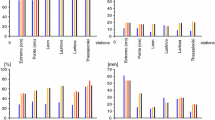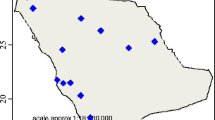Summary
In this study, generalised extreme value (GEV) and generalised Pareto distributions (GPD) were fitted to absolute minimum winter (AMINW) and maximum summer (AMAXS) temperatures, and the daily minimum winter (DMINW) and maximum summer (DMAXS) temperatures in Belgrade, respectively. It was found that both distributions are reasonable. Inclusion of the trend and the North Atlantic Osallation index as covariates in the location parameter when applying the GEV fit to the AMINW temperatures resulted in a significant improvement over the model without covariates. The estimated return levels for 100-year and 10-year return periods using the GEV and GPD were obtained for both seasons.
Similar content being viewed by others
References
Alexandersson H (1995) Homogeneity testing, multiple breaks and trends. In: Proc. 6th Int. Meeting on Stat. Climatology, Galway, Ireland, pp 439–441
J Beirlant Y Goegebeur J Segers J Teugels (2004) Statistics of extremes: theory and applications Wiley Chichester, England
I Bordi K Fraedrich M Petitta A Sutera (2007) ArticleTitleExtreme value analysis of wet and dry periods in Sicily Theor Appl Climatol 87 61–71 Occurrence Handle10.1007/s00704-005-0195-3
Y Castro-Díez D Pozo-Vázquez FS Rodrigo MJ Esteban-Parra (2002) ArticleTitleNAO and winter temperature variability in southern Europe Geophys Res Lett 29 1960–1963 Occurrence Handle10.1029/2001GL014042
SG Coles (2001) An introduction to statistical modeling of extreme values Springer London
DR Easterling B Horton (1997) ArticleTitleMaximum and minimum temperature trends for the globe Science 227 364–367 Occurrence Handle10.1126/science.277.5324.364
DR Easterling LG Evans PY Groisman TR Karl KE Kunkel P Ambenje (2000) ArticleTitleObserved variability and trends in extreme climate events: a brief review Bull Amer Meteor Soc 3 417–425 Occurrence Handle10.1175/1520-0477(2000)081<0417:OVATIE>2.3.CO;2
Gilleland E, Katz R (2005) Tutorial for the extremes toolkit: weather and climate applications of extreme value statistics, http://www.assessment.ucar.edu/toolkit.
DY Gong YZ Pan JA Wang (2004) ArticleTitleChanges in extreme daily temperatures in summer in eastern China during 1955–2000 Theor Appl Climatol 77 25–37 Occurrence Handle10.1007/s00704-003-0019-2
JW Hurrel (1995) ArticleTitleDecadal trends in the North Atlantic Oscillation regional temperatures and precipitation Science 269 676–679 Occurrence Handle10.1126/science.269.5224.676
IPCC (2001) Climate Change 2001: The Scientific Basis. Contribution of Working Group I to the Third Assessment Report of the Intergovernmental Panel on Climate Change. In: Houghton JT, Ding Y, Griggs DJ, Noguer M, van der Linden PJ, Dai X, Maskell K, Johnson CA (eds). Cambridge University Press, Cambridge, United Kingdom and New York, NY, USA, 944 pp
A Kattenberg F Giorgi H Grassl GA Meehl JFB Mitchell RJ Stouffer T Tokioka AJ Weaver TMI Wigley (1996) Climate models – projections of future climate JT Houghton LG Meira Filho BA Callander N Harris A Kattenberg K Maskell (Eds) Climate change 1995 Cambridge University Press Cambridge 285–357
RW Katz MB Parlange P Naveau (2002) ArticleTitleStatistics of extremes in hydrology Adv Water Resour 25 1287–1304 Occurrence Handle10.1016/S0309-1708(02)00056-8
J Kyselý (2002) ArticleTitleProbability estimates of extreme temperature events: stochastic. modelling approach vs. extreme value distributions Stud Geophys Geod 46 93–112 Occurrence Handle10.1023/A:1019841717369
R Reiss M Thomas (2001) Statistical analysis of extreme values from insurance, finance, hydrology and other fields Birkhauser New York
Smith RL (2003) Statistics of extremes, with applications in environment, insurance and finance. http://www.stat.unc.edu/postscript/rs/semstatrls.ps, 62 pp
M Unkašević D Vujović I Tošić (2005) ArticleTitleTrends in extreme summer temperatures at Belgrade Theor Appl Climatol 82 199–205 Occurrence Handle10.1007/s00704-005-0131-6
Vinther BM, Hansen AW, von Storch H (2006) A major deviation from the NAO temperature seesaw pattern. Geophys Res Lett (in press)
ZW Yan PD Jones TD Davies A Moberg H Bergström D Camuffo C Cocheo M Maugeri GR Demarèe T Verhoeve E Thoen M Barriendos R Rodrigues J Martin-Vide C Yang (2002) ArticleTitleTrends of extreme temperatures in Europe and China based on daily observations Climatic Change 53 355–392 Occurrence Handle10.1023/A:1014939413284
Author information
Authors and Affiliations
Corresponding author
Additional information
Correspondence: I. Tošić, Department of Meteorology, Faculty of Physics, University of Belgrade, PO Box 368, Dobračina 16, 11000 Belgrade, Serbia
Rights and permissions
About this article
Cite this article
Unkašević, M., Tošić, I. Changes in extreme daily winter and summer temperatures in Belgrade. Theor Appl Climatol 95, 27–38 (2009). https://doi.org/10.1007/s00704-007-0364-7
Received:
Accepted:
Published:
Issue Date:
DOI: https://doi.org/10.1007/s00704-007-0364-7




